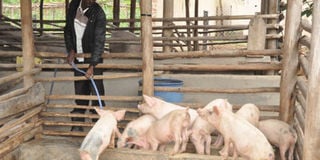On a small budget how I optimally feed my pigs?

On a small budget how I optimally feed my pigs?
Jackline Musimenta
Dear Jackie
A good feeding regime should provide the nutritional needs of pigs depending on age, weight and stage of production.
Commercial pig meals are very expensive but really contribute to faster growth rate as well as provide them with balanced nutrients hence if you have a small budget, you are not advised to venture here.
In an effort to minimise cost with least disturbance on availability of nutrients, ingredients can be sort in the now expanding market to formulate your meals at home. They include maize bran, cotton-seed and pre-mixed vitamins.
Alternatively, feed them on cheaply available stuff classed in energy sources like maize, cassava, sweet potato roots and vines; protein sources like milk and milk by products and minerals, vitamins and water. Avoid feeding pigs directly on leftovers.
Lastly, records will help you do the decision making and make adjustments where necessary.
Answered by Samuel Ssewagudde a veterinary doctor
How can I tell that my poultry farm has been attacked by influenza?
Elias Obwana
Dear Elias
When the birds have been attacked with bird flu, the farmer should be able to see the following in the flock.
Respiratory symptoms
Influenza is a respiratory virus, so birds with bird flu may exhibit respiratory symptoms such as coughing, wheezing, nasal discharge and in some cases tinged with blood.
Behavioral changes
Birds with avian influenza often behave differently than before they became infected. For example, they may seem depressed or inactive and may eat and drink less than normally. The birds may also suddenly seem uncoordinated, and become unable to stand or walk normally.
Egg production
Egg laying birds with avian influenza often produce fewer eggs than before they were infected. And in most cases, the egg shells may be soft or misshapen.
Physical signs
Some signs of avian influenza in birds are physically apparent. For example the feathers may become ruffled, the combs and waddles on poultry can appear a bluish-purple color, and swelling may appear on the combs, waddles, hocks, eyelids and heads as well.
Gastrointestinal symptoms
These appear inside or within the stomach and in the internal parts of the bird. Diarrhea may also develops in some birds with avian influenza.
Other symptoms may include; sudden death without any signs, lack of coordination, lack of energy and appetite, swelling of the head, eyelids, comb, wattles and hocks, sneezing, bird dozing, poor breathing, low appetite for feed and general weak appearance.
Answered by Dr Samuel Nsubuga a veterinary doctor
Part of my banana plantation has turned yellowish yet it’s raining, could it be the weevil? Ivan Nkurukenda
Dear Ivan
A health banana plantation has vibrant banana stems but when you start seeing a change, just know there is a problem. Since bananas are attacked by different diseases and pests, it is advisable to inquire from an expert. If the plantation has been affected by weevil, expect to see the following;
•Leaves turn yellowish and drop prematurely.
•When the banana stem has small pinhead-sized holes on the base of the stem and from these holes gummy substance come out.
•Stunted growth and weak or dying suckers.
•The bananas will take long to flower and when it flowers, the bunch is too small and the maturity is slowly.
•when it manifests heavily, extensive damage will be noticed on some banana pseudo stems, they may start breaking from the base.
Answered by Moses Lumu, an agronomist and consultant
I intend to keep goats in Nakasongola District. I need to know the best breed that can cope well with the environment and where I can buy them from?
Moses Kasita
Dear Moses
German Alpine or Toggenburg exotic breeds can perform well around your area. In particular, crosses of either breed with indigenous goat breeds such as the Small East African or Galla have been found to do well especially if the hybrid has about 75 per cent of the exotic genotype.
Answered by Samuel Ssewagudde
a veterinary doctor
How can I make my own IMO solution?
Simon Peter Galenga
Dear Simon
In natural farming, Indigenous Microorganism (IMO) is becoming popular among farmers.
This Indigenous microorganism (IMO) has been successfully tried by government agriculturists, academic researchers, non-profit organizations and farmers alike.
They have found that IMO is useful in removing bad odors from animal wastes, hastening composting, and contributing to crops’ general health.
How to make your own indigenous Microorganism (IMO):
1. Cook a kilogramme of rice, preferably organic. After cooling, put the cooked rice in a wooden, earthen or ceramic container. Avoid plastic or aluminum.
2. Cover the lid of the container completely with cloth or paper, fixed in place with a rubber band, to prevent water or small insects from getting in.
3. Put the covered container, protected from possible rain, under the trees, in a banana plantation, a forest floor, or wherever a thick mat of leaves has formed. Leave it there for three days.
4. After whitish moldy filaments have formed, transfer the entire contents of the container to a larger glass or earthen jar and add one kilogramme of brown sugar or molasses, preferably organic.
5. Cover the jar with clean cloth or paper, fixed with a rubber band. Keep the jar in a dark, cool place. Let it ferment for seven days, until it appears muddy. This is your IMO concoction.
Answered by Samuel Ssewagudde
a veterinary doctor




